Paul Carey-Kent, freelance writer-curator and former Editor at Large
of Art World magazine, was invited to write about Alison Gill’s new sculpture.
 |
| Paul Carey-Kent and Alison Gill at CERN LHC-P5 CMS December 2013 |
“An exhibition on this site is bound to raise the question of the
differences between science and art. Alison Gill is a good choice in that
context: she trained as sculptor, teacher, has studied psychoanalysis, and has
taken a keen interest in scientific and mathematical matters – as illustrated
by the drawings of knots which she is showing alongside her sculptural
installation.
The way Gill operates bears comparison with the position taken by the
American philosopher Willard Van Orman Quine (1908-2000). He came to prominence
by opposing the well-established distinction between analytic and synthetic
truths. Previous orthodoxy held that the former, such as ‘2 +2 = 4’, are true
by virtue of the meaning of their words and terms, and remain true come what
may; whereas the latter, such as ‘snow is white’, require the evidence of extra-linguistic
facts in the world. This might be seen as paralleling the contrast
between the logical investigations of a physicist and the artist’s more instinctive
pursuit of meaning. Quine held a holistic view under which the truth of a
particular statement depends on its position in the surrounding discourse of
statements, and in which statements might be located on a continuous field. Imagine
that field as a circle, with the external world surrounding it: synthetic
statements would be towards the edge, readily affected by observation of the
external world; whereas analytic statements would be found towards the middle -
it’s not that they can’t be changed, but that a great deal needs to happen to
produce an effect so far from the periphery. To illustrate how that might work,
Quine himself suggested that as a result of all the developments in physics in
the 20th century, there’s a plausible case for replacing classical logic by
quantum logic.
So, in Quine’s view, there aren’t the sharp divisions we might
expect between types of knowledge; and he claimed that it’s the whole field of
knowledge, not just single statements in isolation, which are to be verified.
All scientific statements are interconnected, and we should judge the truth of
the explanatory system to which they give rise. Contemporary art operates
similarly, in that almost anything can be presented within the framework of
art, and the effect and meaning of any one work often depends on its place in
the whole nexus of art’s history and current practice.
It makes sense, then, that Gill’s work brings together
interests in topology, the physical sciences, psychoanalysis, folklore and, of
course, art; yet does not treat those as different in kind, but as points of
equal interest on a continuum. That makes it appropriate to suggest an affinity
with Blake, who was writing at a time when poetry, philosophy and science felt
like part of one large project of enquiry. The discipline of
sculpture suits this approach, given that, as Gill herself says, ‘it is
dealing with matter and its absence, material both seen and unseen’; and that
leads her into what she calls ‘the dimension of not knowing’.
So how does the work which Gill has made for CMS at CERN fit in
with this? In the six sculptures which make up Stranger Than Paradise, magnetised objects hang in steel frames
with dimensions taken from Giacometti’s early Surrealist works. They operate in
abstract terms, but also reference scientific modelling, and in doing so they alternate
between micro and macro levels. Just what are those cratered balls with blind
alleys, tunnels and holes? Atomic particles? Planets? Or people in
relationships? Gill points to the potential narrative of those relations
through the sub-titles of these pieces, all of which incorporate a fairy tale
which can also be read as linking to one of the six particles which are quarks
in the Standard Model: Sleeping Beauty
(Beauty/Bottom); Rumpelstiltskin (Strange);
Tom Thumb (Down); Rapunzel (Truth/Top); Frog Prince (Charm) and Magic Bean (Up).
The science of Stranger Than
Paradise is too simple to deceive. Everyone understands magnetic force. Yet
a residual air of mystery does remain whenever bodies act without visible
cause. And if the objects do stand in for people, they put me in mind of how
behaviour can appear to come from nowhere, even the extremes which are seen in
those early Giacometti sculptures. Our
speculation as to causes will be rooted in psychology rather than science. That
might set us wondering, though, whether the former might eventually be reduced
to the latter through an ultimate understanding of the chemistry and physics of
the brain, just as the sculpture’s interactions can be explained by magnetic and
gravitational laws.
What are the shapes, by the way? Gill explains that they all began
from either the sphere or a Russian doll, and that, too, provides an
appropriate combination of contrasts: they start from either perfect
rationalism, for which read science or maths; or from a sequential
concatenation of myth, from art or religion.
Detector
(Kissing Gate) also uses the invisible force of magnetism,
but to rather different effect – to influence the opening, closing and turning
of a sculptural circle which becomes a portal. Here again the art and non-art
references come together. This is a gate, a potential point of entry to
alternative experiences, including, perhaps, the magnetic attractions of
romance. It also looks like a bicycle
wheel removed from its context, which summons Duchamp’s first readymade. The
sculptural placement of string across a hole brings Barbara Hepworth to mind.
But its pattern takes us back to Gill’s interest in topology: it’s a ‘Mystic
Rose’ produced by linking equidistant points around a circle to each other.
The Space Matter
Problem (50 x 40 x 20) completes Gill’s set of CERN pieces. It
takes off from cast forms of some banality: a carry-on suitcase designed to fit
the stated maximum measurements allowed by airlines, and a star-shaped perfume
bottle. Those are subjected to changes in the manner of a scientific experiment
in form: the plaster casts are folded, fragmented, have holes cut into them and
have been thrown down stairs. They’re covered in chemical indigo – the colour
traditionally used for night skies in illuminated manuscripts – and peppered
with starry traces of mica. The multi-form results are arranged according to scale
on tables which are actually the art-meets-maths-meets-academia surface of blackboards
with chalk grids.
There’s a fiercer energy implied here than in the magnetic pieces,
and the damaged suitcase may suggest that an on-plane explosion has occurred.
But that’s not out of place: there is an obvious violence to the Hadron Collider’s
extravagant electromagnetic enforcements. And the evolution of the atom bomb
will always lurk behind such experiments. Gill’s own thesis on Giacometti's Surrealist
work was called ‘The Poetics of Destruction’, and a quotation from that picks
up on the connection between destruction and desire, another holistic aspect of
reality: ‘Giacometti sought to understand reality and to survive it. He worked
in the hope of grasping the whole of his vision. This was his desire. Bataille
viewed 'destruction of what is there before the subject' as the premise for
'the enactment of desire'. He wrote ' Art since it is constantly art, proceeds
in this by successive destructions. Thus in so far as it liberates instincts,
these are sadistic.'
Alison Gill shows us that, whether or not you can ‘hold infinity
in the palm of your hand’, you can pause in the course of momentous scientific
investigations to take in another perspective on the haunting unity of what
surrounds us.”
December 2013 at CMS CERN/ LHC-P5
 |
| Alison Gill December 2013, preparation of her Stranger Than Paradise installation |


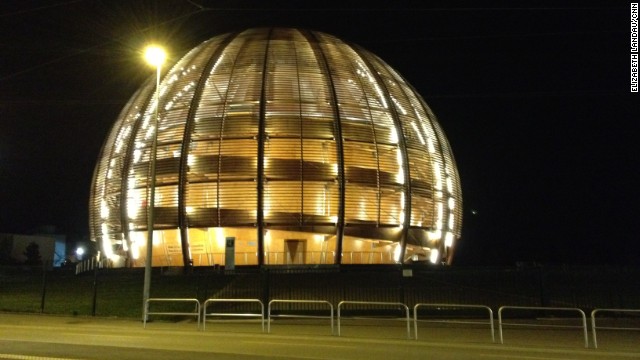 The Large Hadron Collider is located at CERN, the European Organization for Nuclear Research, near Geneva, Switzerland. This is CERN's Globe of Science and Innovation, which hosts a small museum about particle physics inside. The ATLAS experiment, which also detected the Higgs boson, is housed underground nearby.
The Large Hadron Collider is located at CERN, the European Organization for Nuclear Research, near Geneva, Switzerland. This is CERN's Globe of Science and Innovation, which hosts a small museum about particle physics inside. The ATLAS experiment, which also detected the Higgs boson, is housed underground nearby.
 The Higgs boson, the elusive particle that scientists had hoped to find for decades, helps explain why matter has mass. This is part of CMS, one one of the experiments that detected the particle.
The Higgs boson, the elusive particle that scientists had hoped to find for decades, helps explain why matter has mass. This is part of CMS, one one of the experiments that detected the particle.
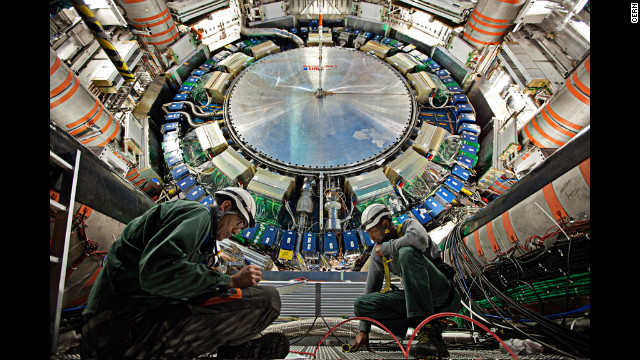 The ATLAS experiment, seen here in 2011, is about two stories taller than CMS. The Higgs boson has been called the "God particle" because of a book by that title, but scientists hate the name.
The ATLAS experiment, seen here in 2011, is about two stories taller than CMS. The Higgs boson has been called the "God particle" because of a book by that title, but scientists hate the name.
 Much of three stories of electronics at CMS are involved in making split-second decisions about what data to keep and what to discard. This is one of those areas.
Much of three stories of electronics at CMS are involved in making split-second decisions about what data to keep and what to discard. This is one of those areas.
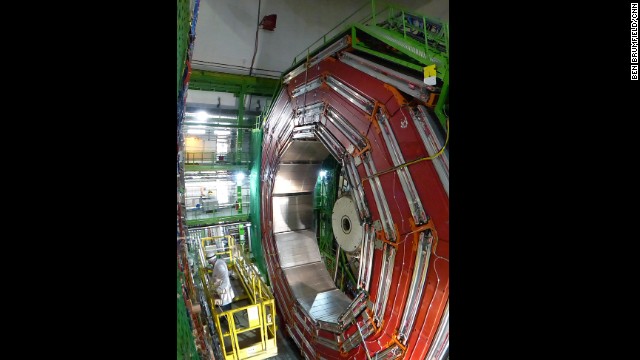 A technician works on the CMS experiment. Technicians are adding new cooling lines for CMS for a system that will be put in place in two or three years.
A technician works on the CMS experiment. Technicians are adding new cooling lines for CMS for a system that will be put in place in two or three years.
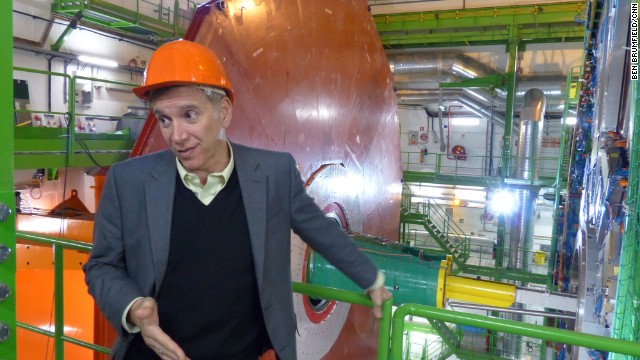 Joe Incandela, the spokesperson for CMS, says that about 4,000 scientists collaborate on the experiment. Behind him is a new red-colored layer to improve the detection of muons, which are fundamental particles
Joe Incandela, the spokesperson for CMS, says that about 4,000 scientists collaborate on the experiment. Behind him is a new red-colored layer to improve the detection of muons, which are fundamental particles
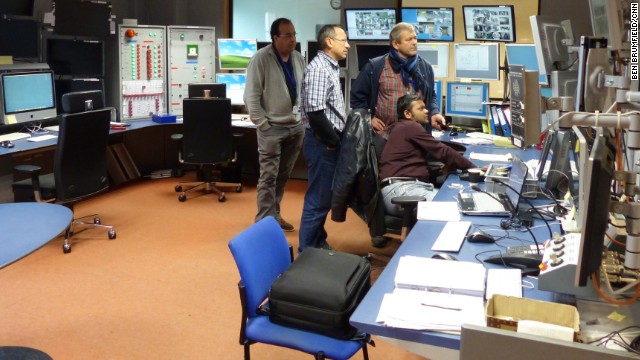 Physicists in the CMS control room. Although the particle accelerator is shut down until 2015, this is a busy time for everyone involved in upgrading the particle detectors and analyzing data from the first run of particle collisions.
Physicists in the CMS control room. Although the particle accelerator is shut down until 2015, this is a busy time for everyone involved in upgrading the particle detectors and analyzing data from the first run of particle collisions.
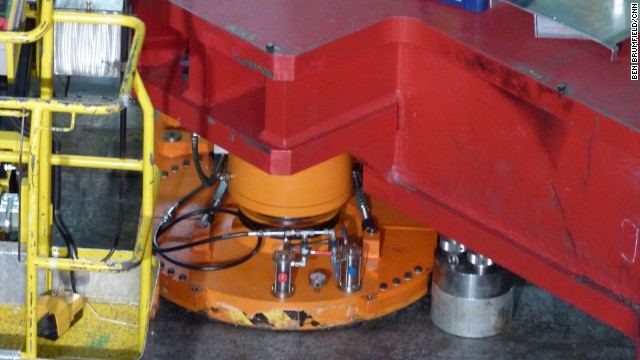 The nearly 14,000 tons of machinery can all collapse together, or separate, when high-pressure air is pumped in. This is one of the pads to help slide it all around.
The nearly 14,000 tons of machinery can all collapse together, or separate, when high-pressure air is pumped in. This is one of the pads to help slide it all around.
 CMS has 76,000 lead-tungstate crystals that shatter electrons and photons, allowing scientists to observe particles such as the Higgs boson that exist for only an instant. Some of those crystals are in the endcap.
CMS has 76,000 lead-tungstate crystals that shatter electrons and photons, allowing scientists to observe particles such as the Higgs boson that exist for only an instant. Some of those crystals are in the endcap.
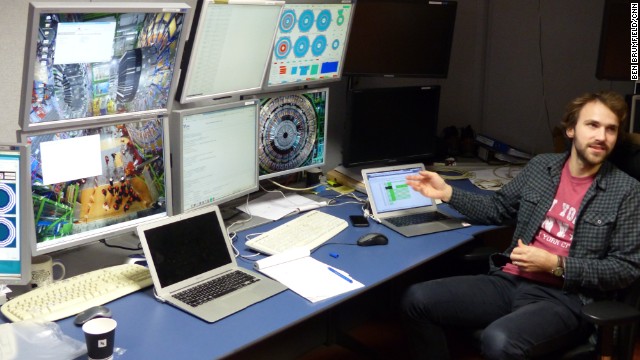 Evaldas Juska, an engineer, is working on computers involved with CMS.
Evaldas Juska, an engineer, is working on computers involved with CMS.
 CMS was constructed at ground level, then pieces of it were lowered through this hole in the cavern.
CMS was constructed at ground level, then pieces of it were lowered through this hole in the cavern.
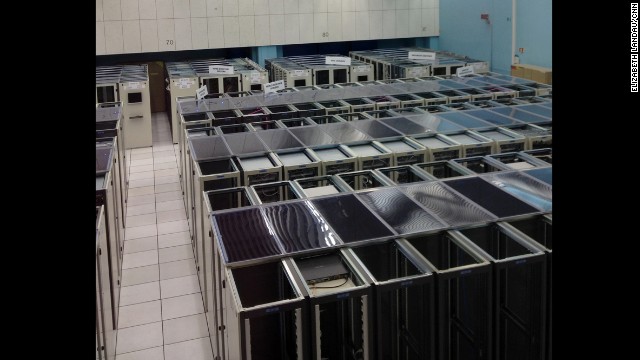 This is the CERN Computing Center. Tim Berners-Lee invented the World Wide Web at CERN.
This is the CERN Computing Center. Tim Berners-Lee invented the World Wide Web at CERN.
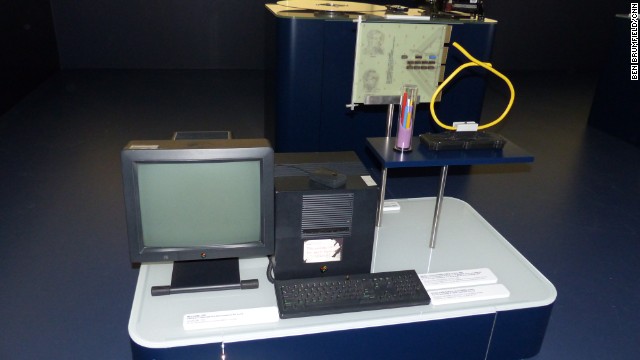 One of the world's first web servers, a NeXT computer from 1991, is seen at CERN. The handwritten note indicates, "This machine is a server. DO NOT POWER DOWN!" On the right is an old Ethernet cable, which can handle only 10 Mb/second, and was largely replaced by the mid-'90s.
One of the world's first web servers, a NeXT computer from 1991, is seen at CERN. The handwritten note indicates, "This machine is a server. DO NOT POWER DOWN!" On the right is an old Ethernet cable, which can handle only 10 Mb/second, and was largely replaced by the mid-'90s.
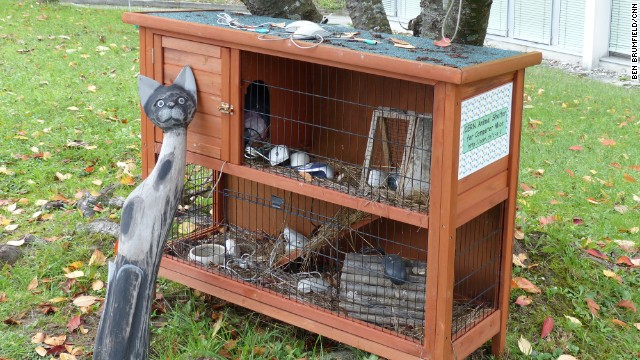 While they take their work seriously, that doesn't mean the scientists at CERN don't have a sense of humor. Here we see CERN's "Animal Shelter for Computer Mice," where used and unwanted computer mice have a place to call home.
While they take their work seriously, that doesn't mean the scientists at CERN don't have a sense of humor. Here we see CERN's "Animal Shelter for Computer Mice," where used and unwanted computer mice have a place to call home.
 CERN's Restaurant 1 has a water fountain with options such as "order," "chaos" and "self-destruct." CNN's Elizabeth Landau tasted all three and could not detect a difference.
CERN's Restaurant 1 has a water fountain with options such as "order," "chaos" and "self-destruct." CNN's Elizabeth Landau tasted all three and could not detect a difference.
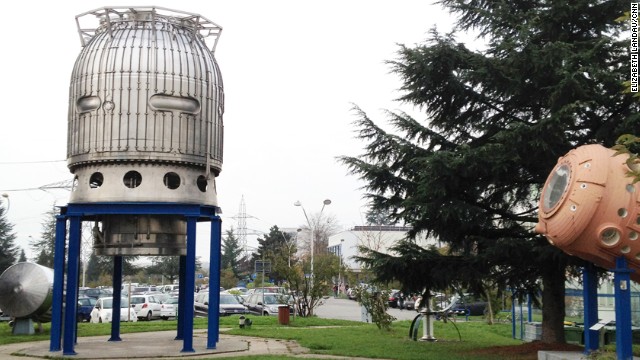 A sculpture garden featuring artwork made from pieces of old experiments decorates the grounds at CERN.
A sculpture garden featuring artwork made from pieces of old experiments decorates the grounds at CERN.
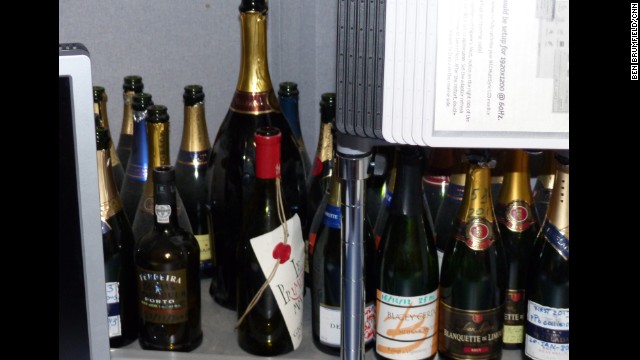 A collection of empty relics from the celebrations of different milestones of the CMS experiment.
A collection of empty relics from the celebrations of different milestones of the CMS experiment.
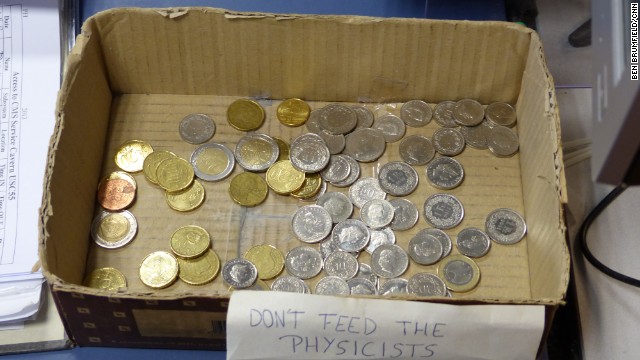 "Don't feed the physicists" marks a box of coins where CMS scientists deposit change to pay for coffee
"Don't feed the physicists" marks a box of coins where CMS scientists deposit change to pay for coffee 


 Christoph Löhr ist freier Journalist und Autor in Bonn. Er arbeite sowohl für diverse Zeitungen und Magazine, als auch im Auftrag von Agenturen und Direktkunden.
Christoph Löhr ist freier Journalist und Autor in Bonn. Er arbeite sowohl für diverse Zeitungen und Magazine, als auch im Auftrag von Agenturen und Direktkunden.